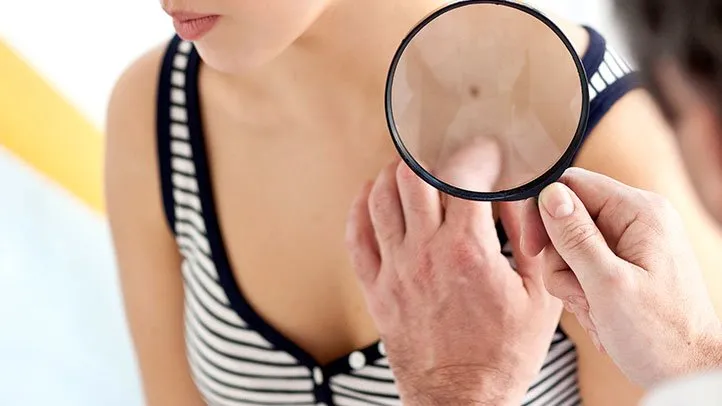Signs and Symptoms of Skin Cancer
The different types of skin cancer can look different and may be more likely to appear in certain areas of your body. Some may share similar characteristics, however.
Basal Cell Carcinoma Symptoms
Basal cell cancer can appear anywhere but tends to develop on parts of the body that get a lot of sun exposure, such as the face, head, and neck.
- Small pink, red, pearly translucent, or shiny bumps, possibly with areas of blue, brown, or black
- Pink growths with slightly raised edges and an indentation in the center; tiny blood vessels might run through it like the spokes of a wheel
- Open sores, possibly with oozing or crusted areas, that don’t heal or that go through cycles of healing and bleeding
- Flat, firm, pale, or yellow areas that resemble a scar
- Raised, reddish patches of skin that might be itchy or irritated
- Delicate areas that bleed easily, such as a sore or cut that lingers longer than one week
These slow-growing skin cancers can be easy to ignore unless they become big and begin to itch, bleed, or even hurt.
Squamous Cell Carcinoma Symptoms
Like basal cell cancer, squamous cell cancer tends to develop on parts of the body that get a lot of sun, such as the face, neck, ear, lips, and back of the hands. It might also appear in scars or skin sores anywhere on the body.
- Rough or scaly red patches that may bleed or crust
- Raised growths or lumps, sometimes with a depression in the center
- Open sores, possibly with oozing or crusted areas, that don’t heal or that go through cycles of healing and bleeding
- Growths that resemble warts
Melanoma Symptoms
Melanoma can develop anywhere on the skin but is more likely to start on the chest and back in men and on the legs in women.
People with darker skin pigment are significantly less likely to get skin cancer in these areas than those with lighter skin. Melanoma may develop, however, on the palms of the hands, the soles of the feet, in the eyes, or underneath the nails.
About 30 percent of melanoma cases begin as existing moles, but they also may appear on otherwise normal skin. One way to assess if a spot is melanoma is to use the ABCDE system, examining if it has the following characteristics.
- A is for asymmetry. One half of the spot does not match the other.
- B is for border. Edges are irregular, scalloped, or notched.
- C is for color. Parts of the spot may be different colors, from shades of tan, brown, and black, to red and blue.
- D is for diameter. The spot is bigger than the eraser on a pencil, about ¼ inch.
- E is for evolving. The spot changes in size, color, shape, and elevation.
Not all moles will develop into melanoma. And some melanomas don’t neatly fit into the ABCDE categories, as well. If you notice changes in a spot on your skin, or if it does not heal or appears unusual, talk to your doctor.

